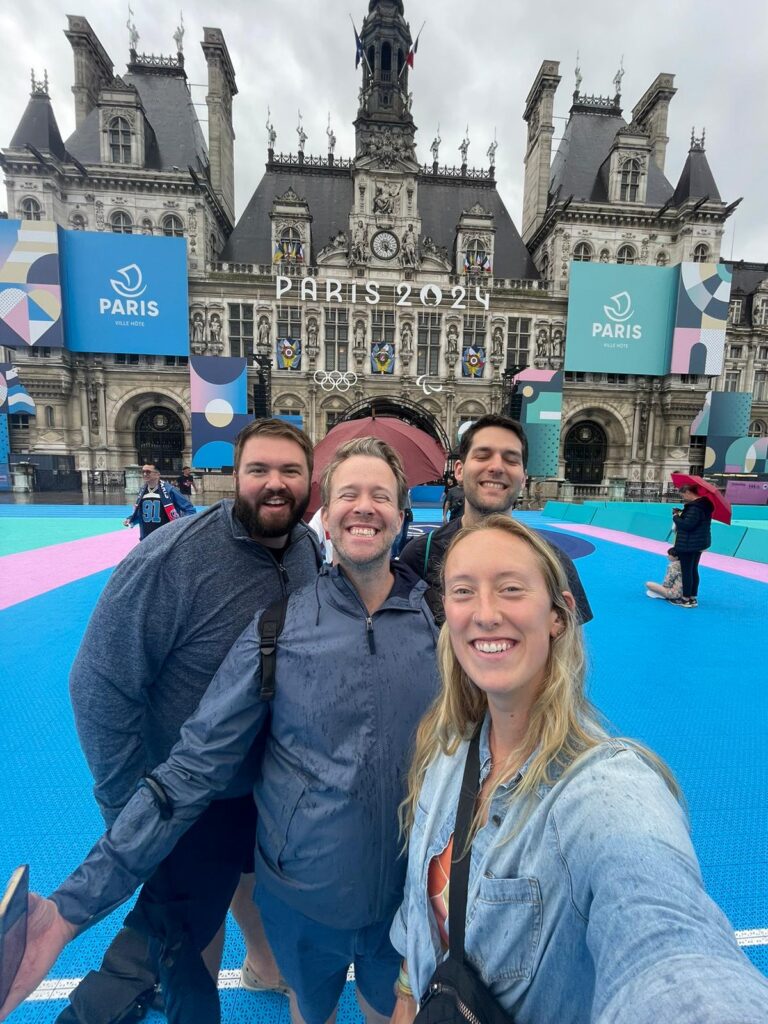From AIA National: “The architecture profession must be as diverse as the world we serve. Achieving this vision has a direct impact on the relevance of our profession and the world’s prosperity, health, and future. AIA is building a profession and an organization of belonging inclusive of race, color, religion, gender, gender identity, national origin, marital status, age, personal appearance, sexual orientation, family responsibilities, political affiliation, physical or mental disability, or veteran status and beyond.”
As we come to the end of both Juneteenth and Pride Month celebrations, I am reminded more than ever of the role architects and architecture play in building community and sense of belonging. Especially as a non-architect myself, I regard this profession as one needing to be at the forefront of these issues.
Last July, I was blessed to be able to travel to France for three weeks in the lead-up to the Paris Olympics. I had caught the bug for travel a few years prior and, after saving for this bucket-list trip for five years, finally found myself there. France, and Europe in general, is a wonderfully diverse land, but being in the epicenter of the premiere world athletic event found me appreciating even more the beautiful diversity of our human race. The closest I can describe the energy around an Olympic Games, and especially the Opening Ceremonies, is that of an extended New Year’s Eve. There is camaraderie, joy, and a deep understanding that, while you want your nation to win the medals, you also want everyone else to prosper and have a good time. There is a brotherhood, a familial sense that we are all, at the end of the day, the exact same with the same wants and needs. We all desire shelter, we all need food, we all benefit from beauty and fun in our lives.
And one of the most critical ways to bring about this shared sense of humanity, this prospering of all people, is twofold related to architects. One, the built environment shapes us mentally, emotionally, spiritually, and physically more than anything else (outside of perhaps our literal diet). Two, the profession of architecture – those that help build these most important of spaces and places – acts as a clarion call to who should represent us as humans in regards to who has a say in the shaping of these things. Who comprises this profession – your profession – is of great importance. Of course, we welcome all (that is the point of inclusion), but we also acknowledge the systematic barriers that for so long prevented folks from being accepted for who they are and letting them just get on with their lives and be good designers.
Because of where we are in the calendar year, I am specifically reminded of folks in our nation that, for decades, were not treated as equal due to the simple fact that they had darker skin than others. The celebration of Juneteenth, for example, is a reminder that this nation can overcome the worst, most racist aspects of humanity and create a future – and ideally, a present – where a non-controllable genetic trait like skin tone is viewed the same as eye color or what hand you write with. The lived experience of communities that have dealt with racism matters and those voices are critical in building both physical structures and a profession that understands the whole of the human experience.
Equally true, our nation (and humanity) have done a terrible job at accepting people for their sexuality, something that I can attest to firsthand. I have known since I was a child that I was a man attracted to other men, and I am grateful that, having been born in 1990, I missed most of the homophobia of the 1980s and 1990s, even though while I a teenager in the 2000s there were still laws being enacted across the nation which treated folks like me like a second-class citizen. But I found respite in those times when I was discovering who I am – many dark times to be sure – in not only the friends I had, but the physical spaces that brought me joy. Anything and everything from the dining hall at the summer camp I attended to the Victorian buildings on Capital Street in my hometown of Charleston, West Virginia. When people were cruel, buildings were not. And in the built environment, I found hope. In architecture itself, I found belonging, and was reminded of the best of humanity. This is your calling; this is the good you can do.
As we move into the Independence Day weekend over the next few weeks, let us not only celebrate the extended freedoms that this country has brought for marginalized people, but let us celebrate the continuing diversification of the profession of architecture. Who designs our buildings matters, because those designs – considerations that range from exposure to natural light to facade aesthetics to methods of cooling and heating – will impact a diverse range of humans with a diverse range of stories and experiences. Those buildings and the architects that envision them can achieve the highest moral good that humanity can strive for: creating community. I love this profession because it inspires me. It gives me hope. And the more voices we have shaping the spaces that shape us, the more our built environment can craft a sense that we are all in this together, even if we have different goals. Just like the Olympics.
Find more resources on this at AIA National here: https://www.aia.org/design-excellence/equity-diversity-inclusion
Want to make your voice heard and help others in our community do so? Want to make sure our profession is at the forefront of inclusion and building a world for all? Join our monthly EDI Committee Meetings! For more information email me at dustin@aiaetn.org
